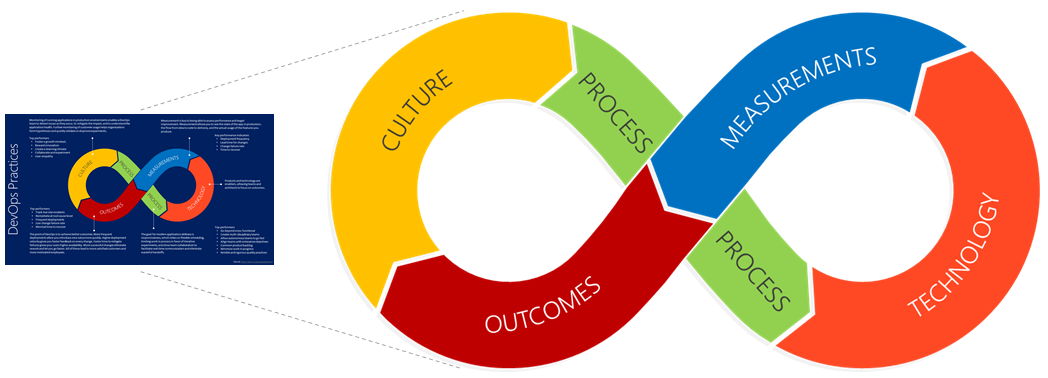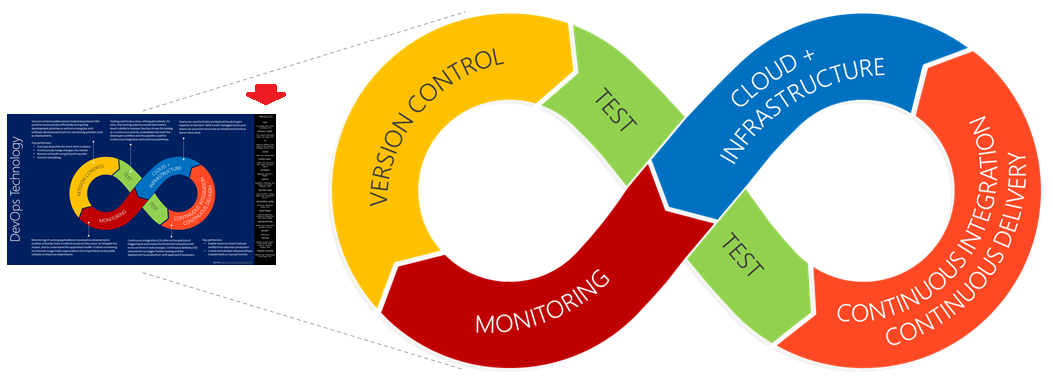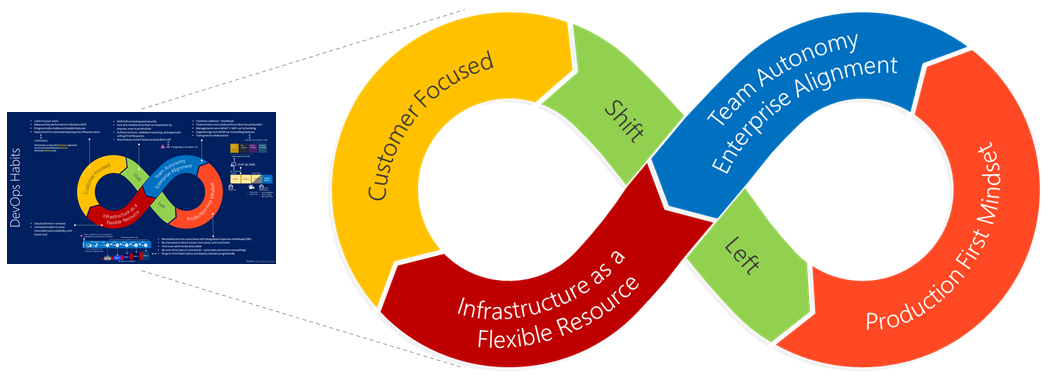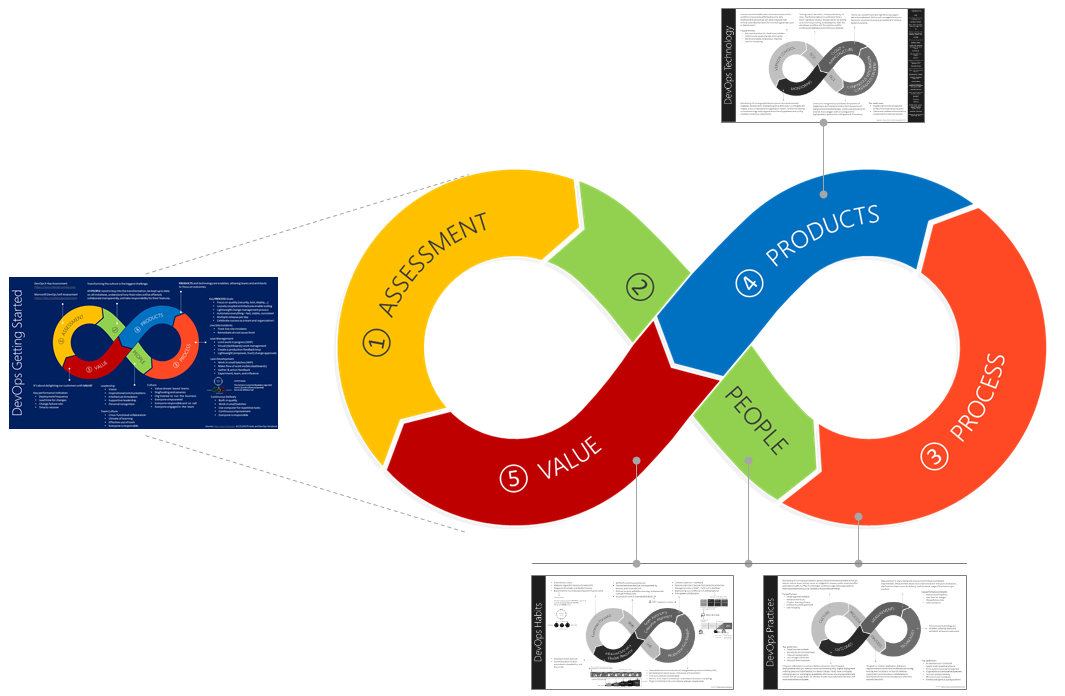THIS IS AN EARLY DRAFT - TECHNICAL AND COPY EDITING PENDING!
Organizations are investing in a move from resource optimized model, based on capital expenses (CAPEX), to a market optimised business model, based on operational expenses (OPEX). It's about time to market and continuously delighting customers with value!
Welcome to digital transformations, embracing a DevOps mindset in your organization!
As defined by Donovan Brown, "DevOps is the union of people, process, and products to enable continuous delivery of value to our end users."
DevOps is not about magical unicorns and colorful rainbows. It's a journey of continuous learning and improvement, with a destination you never quite get to! It's the reason that all of the images herein, are based on the infinity symbol.
None of this is new to you, you're eager to explore DevOps, and probably asking yourself "how do we get started?"
Being a visual minded person, I created a presentation with posters to seek answers for the recently hosted Global DevOps Bootcamp (GDBC). It's an annual community driven event, hosted around the globe on the same day, to create an environment in which we can collaboratively explore digital transformations and DevOps insights.
Let's explore four of the quick reference posters, also referred to as visuals and infographics. For a more in-depth discussion of DevOps, refer to the DevOps Handbook, by Gene Kim, Jez Humble, Patrick Debois, and John Willis.
The first two posters are based on the DevOps Assessment and intended to be used when reviewing the assessment results with all stakeholders. The first introduces five key practices.
Top performers encourage a culture that fosters a growth mindset, reward innovation, collaboration, experimentation, learning, and user empathy. Strive for a process with a responsive application delivery, flexible scheduling, and iterative experiments. Monitor, identify and mitigate issues, and continuously eliminate wasteful bottlenecks. Only valuable key performance indicators are measured and used to strive for better outcomes, such as a low change failure rate (CFR), minimal time to recover (MTTR), and remediation of issues at root level. Lastly, technology, which is an enabler, is the focus of the next poster.
Here's a companion of the practices poster, focused on technology.
Version control manages versions of your application, configuration, infrastructure, and other code. It enables team collaboration and monitoring activities, such as deployments. Top performers use topic branches for short-term isolation, continuously merge changes into master, review and audit using Git pull requests, and version everything. Testing must be viewed as a continuous activity, embedded into both the developer workflow and the continuous integration (CI) and continuous delivery (CD) pipeline. The Cloud enables you to effectively provision your infrastructure and move as fast as they need. Lastly, monitoring enables you to form a hypothesis, validate or disprove experiments, proactively detect issues as they occur, and understand the application health.
The black bar on the right of the poster lists products to consider when you're investigation technology for your development, production, common engineering, and other environments. Provide feedback on the listed products and regularly update your poster to have the latest version of a volatile and opinionated part of the visual!
Based on the Moving 65,000 engineers to DevOps with VSTS story, this poster is focused on the five key habits we learned about during our transformation. The customer focused, team autonomy and enterprise alignment, and shift left habits are really evolutions of Agile, and the production first mindset and infrastructure as a flexile resource particular to a DevOps mindset.
Customer Focused is part of our quest for delighted customers and our obsession for customer value. You need to actively listen to your users, progressively enable and disable features, perform continuous experiments, and measure key performance indicators. It's important to use all available feedback to maximise learnings and influence value. Shift Left encourages reviews, validations, and approvals for both testing and security as early as possible in the feature delivery cycle to drive quality and a fail-fast mindset. When technical debt exceeds a predefined limit (for example a 5 bugs per engineer) that you're comfortable with, feature teams should encouraged to suspend feature work until the technical debt is paid down. Team Autonomy and Enterprise Alignment is concerned with how we build what, and why. There's a need for a common cadence, or heartbeat, across your organization to enable all your leadership and feature teams to collaborate transparently and effectively. A core learning is that the most effective feature teams are those that own a feature from idea to production, with autonomy how they develop and support their features.
Production first is a mindset that does not differentiate how features and bugs are handled during development, testing, and operational support. Everything should be automated, versioned, and fine tuned in production. Lean on ring based deployment and rings to limit your blast radius of feature changes in production, remdiate all issus at root cause level, and remember to be transparent about issues, root cause, and resolution. As a user I'll be far more understanding if I have an insight into issues. Infrastructure as a flexible resource is a new buzzword that describes how solution architectures are adapted to the cloud, containerisation, and microservices. It's important to adopt a pragmatic transformation, in a way that makes sense for your organization, goals, products, and culture. As with the previous habits, it's important to favour autonomy over a descriptive architecture, and not to transform everything all at once.
The last visualization we'll peruse in this overview, combines all of the above, and suggests five steps to getting started with DevOps.
I prefer to start with the assessment, to help us identify key areas which can be improved.
-
Assessments give you a benchmark of your DevOps mindset and performance against the rest of the industry. It's important to understand where you're doing well and where investment will help you transform to the next level. Both the Dora and Microsoft DevOps Assessments are great starting points. In addition to the mentioned assessments, you should also gather metrics that can be used as a base to measure progress. For example, deployment frequency, lead time for changes, mean time to repair, and change failure rate.
-
People and culture is your biggest challenge. Everyone needs to buy into the transformation, understand how they will be affected, encourage transparency, be engaged, and take full responsibility for their value streams. This includes the leadership, who need to be supportive, inspirational, empowering, and drive a clear vision. You'll make or break the transformation as a team! Read A 4-step plan for creating teams that aren't afraid to fail, by Catherine Louis, for an insight into how a team will meet its goals thrugh experimentation, failure, leraning, and adjusting.
Without committed people and an experimental culture, the rest of the DevOps transformation journey is futile!
-
Process is your engineering system that enables the teams to manage live site incidents, use lean management and development, and continuously deliver value. A common engineering system will introduce consistency, empower feature teams, and enable and encourage everyone to support and contribute each other. Your top process goals should include a focus on quality, a loosely coupled architecture to enable scaling, lightweight management, automation, multiple releases per day, and celebration of success as a team and as an organization.
-
Products are the easiest link in the chain. They enable everyone to focus on what's important - delivery of value to the end users!
-
Value is all about delighting users! Key performance indicators to measure value include deployment frequency, lead time for changes, change failure rate, and time to recover.
Whether you tackle the steps all at once ("big bang"), step-by-step ("peel an onion"), or gradually innovate your value chain across all steps ("broad spectrum innovation") is your choice. Again, just be pragmatic!
Improvement Is Possible for Everyone, if leadership provides consistent support, and team members commit themselves to the work. - ACCELERATE book, by Nicole Forsgren, Jez Humble, and Gene Kim.
Which visuals do you like? Which add no value? Which are missing? Let's collaborate to facilitate visuals and guidance to help demistify DevOps and make you and your users shine! Users need a positive feeling that they can rely on proven practices, real-world learnings, and that they are not alone.
Looking forward to your feedback and pull requests!




